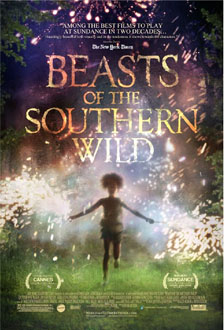
Starts December 20
Original language: English
 “The whole universe depends on everything fitting together just right.” These were the opening words of Hushpuppy (Quvenzhané Wallis), the rambunctious, determined and loveable six-year-old Afro-American girl from a hurricane-endangered, ramshackle bayou community, affectionately called, “the Bathtub”. Even though the Bathtub’s makeshift shacks and trailers are furnished with trash and dinner is sometimes warmed up cat food, Hushpuppy finds it “the prettiest place on earth”. But Hushpuppy’s paradise is in danger of being destroyed by a hurricane brewing in the Gulf and this, in addition to her fear of losing her dying father (Dwight Henry), is threatening to obliterate her universe. When Hushpuppy’s teacher-seer predicts an apocalyptic end of the world when the ice caps melt and then later tells the legend of prehistoric, fierce, ox-like aurochs (“beasts”), Hushpuppy’s imagination runs wild. She envisions that the coming storm will bring this doomsday: the glaciers will melt and the “beasts” will thaw out and come crashing down upon the land.
“The whole universe depends on everything fitting together just right.” These were the opening words of Hushpuppy (Quvenzhané Wallis), the rambunctious, determined and loveable six-year-old Afro-American girl from a hurricane-endangered, ramshackle bayou community, affectionately called, “the Bathtub”. Even though the Bathtub’s makeshift shacks and trailers are furnished with trash and dinner is sometimes warmed up cat food, Hushpuppy finds it “the prettiest place on earth”. But Hushpuppy’s paradise is in danger of being destroyed by a hurricane brewing in the Gulf and this, in addition to her fear of losing her dying father (Dwight Henry), is threatening to obliterate her universe. When Hushpuppy’s teacher-seer predicts an apocalyptic end of the world when the ice caps melt and then later tells the legend of prehistoric, fierce, ox-like aurochs (“beasts”), Hushpuppy’s imagination runs wild. She envisions that the coming storm will bring this doomsday: the glaciers will melt and the “beasts” will thaw out and come crashing down upon the land.
Hushpuppy’s father, a single parent, who is harsh, volatile and sometimes drunk, but loving and protective, knows that he cannot save his daughter from all the dangers that are facing her. He must prepare her to confront her fate alone. His survival teaching methods may be disturbing and even brutal at times, but from this chaotic world we see a fierce, resilient, focused individual emerging who is ready to challenge the “beasts” (whether real or imaginary) and then fit the pieces of her broken universe back into place.
This fantasy drama, a debut feature, was directed and co-written by Benh Zeitlin and came forward as the favorite of the Sundance Film Festival. By using non-actor locals, a hand-held camera which wiggles just enough to suggest a catfish in the water and other artistic devices, Zeitlin creates a tour de force low-budget debut film. Almost the whole cast are non-professionals and they actually come from the communities around the film site. Quvenzhané Wallis, for example, was picked from 4000 other six-to-nine-year-old girls. Among other things she impressed the filmmakers not only with her authenticity but also with her ability to scream and burp upon command, both of which were employed in the film. Similarly, Dwight Henry owns a bakery where the crew used to have breakfast or lunch and only towards the end did he decide to audition for the film. In an interview he stated, “I was in Hurricane Katrina in neck-high water. I have an inside understanding for what this movie is about.” Through Wallis and Henry we have the feeling that we experience the action first hand. They’re not acting, they are the film. It is, in fact, their genuineness as well as the other innovative devices which make the film effortlessly believable.
The score and costumes are perfectly fitting. Zeitlin is also a musician and together with composer, Dan Romer, he creates a score that activates your senses so that you hear and feel the stampede of the beasts or the approach of the storm as the trumpets and piano pulsate or with the chimes you become aware of the simple heartbeat of the beloved animals that Hushpuppy communicates with. It is the perfect frame for Hushpuppy’s sometimes mystic narration. The costumes underline the differences between the “wrong” or wet side of the levee and the “right” or dry side. In the beginning of the film on her side of the levee, Hushpuppy tramps around in orange underwear covered by a white tank top and rain boots on her feet. She never combs her hair and one wonders if she ever takes a bath (even though she lives in “the Bathtub”). Later on when the “good guys” from the dry side of the levee try to rescue her, she is imprisoned in a pretty little crisp and clean dress and her hair is perfectly braided and styled. Her face and body language reveal to us that this is not her world or her people; it does not fit into her broken universe.
There is much “food for thought” in this film. Basically it is a story of a little girl’s struggle to find her place in this universe and her discovery that she has the power to change her fate. But it also gives us a new perspective of what the communities, destroyed by Hurricane Katrina, were like as well as a feeling of the infinite flux of the universe around us. Simultaneously it unravels the story in time – now and forever, in place – local and universal and in mind – real and imaginary.

Filmmaker/composer/animator Benh Zeitlin brought his film The Beasts of the Southern Wild (based on stage play by Lucy Alibar) to participate in the Sundance Institute's Directors, Screenwriters and Producers Lab, a real honor. Together Zeitlin and playwright/storyteller, Lucy Alibar created a very whimsical, magical and abstract narrative for the silver screen. The splendor of the film’s creativity could easily call for a $100 million budget. Since the independent filmmaker rarely has these resources, the institute takes in these types of projects in order to help filmmakers realistically go after a budget that suits their pocketbook. They learn how to tailor their large-budget dreams into using resources fitting for an affordable budget while still creating a powerful message. Zeitlin was given the Institute’s guidance and tools needed to bring his project to fruition. The screenwriter's lab helped the playwright Lucy Alibar change her material to screenwriting, using different transitions with the story best suited for film. The director's lab assisted Zeitlin on how to make the story's creative ideas grow from that solid foundation. The producer's lab was the guide that showed Zeitlin how to package the world of his film into a realistic plan for success. The lessons Zeitlin and Alibar learned were invaluable to the extent that their film was awarded the Sundance/NHK International Filmmakers’ Award.
Zeitlin says, "Alibar's plays are written like delicious concoctions of food, magic, and love, Southern Style."' He always wanted to make one of her plays into a short film but realized that the crazy world she creates needs to be elevated to a full feature to give her art form the proper showcase. Zeitlin adds, "Alibar creates characters with a specific kind of sweetness, subjected to a kind of love so tough it might appear to be cruel if you weren't laughing so hard." The style of their collaboration is so unique that one might not understand the story at times from the dialogue; but, to marvel at the big picture is what will captivate and endear the audience.
Synopsis:
Down on the Louisiana bayou, situated on levee territory is a bayou shrimping community, self-contained and long forgotten by the outside world. Its inhabitants don't rightly know this nor care. Each member of the community tends to his own but, if need be, a helping hand to others will be given. Miss Bathsheba (Gina Montana) gives back to the community every day, especially to children. She is the community school teacher educating her students about natural selection, global warming and ecological changes that could affect their little community more than desired. Her daily message, "Learn to live with one another and adapt!" At the end of the teaching day Miss Bathsheba sends her class home with the words, "Ya'all learn how to survive." Six-year-old Hushpuppy (Quvwnzhane Wallis) let's Miss Bathsheba’s words go into one ear and out the other, while laughing with her classmates as they try to make sense of the warning. They're just kids! And love their teacher as she loves them. Thus, the reason for Miss Bathsheba’s words, because she knows that, although they are still children, they live as adults, caring for their messed-up families in the slums of the bayou. She is well aware that education and encouragement from a mentor will be their guide for survival.
A mighty storm hales the levee territory pushing a large portion of the community to seek higher ground. Hushpuppy and her father Wink (Dwight Henry) along with his moonshine-drinking buddies make a pact to wait out the beasts of the winds, rains and horrific noises of clatter to protect their frail homes. In the midst of the storm Wink becomes deathly ill while their home is sinking. Hushpuppy is frightened! How can she survive? How does she adapt? Where does she go for help? She understands that the universe needs to fit together somehow but witnesses her world collapsing around her from a chain of events taking place caused by a storm, a sinking habitat, and Wink's illness. Hushpuppy must lean into Miss Bathsheba’s teachings and her environment to tame the Beasts of the Southern Wild.
